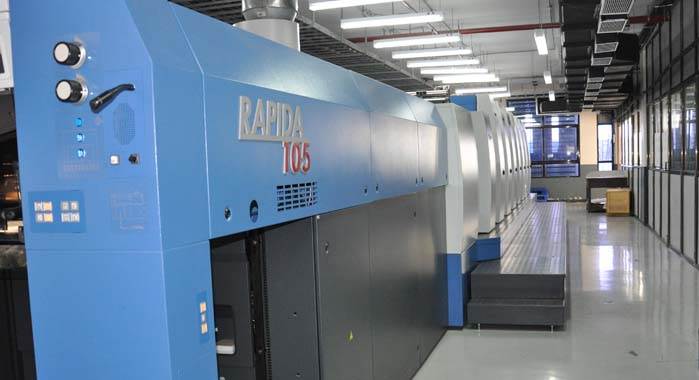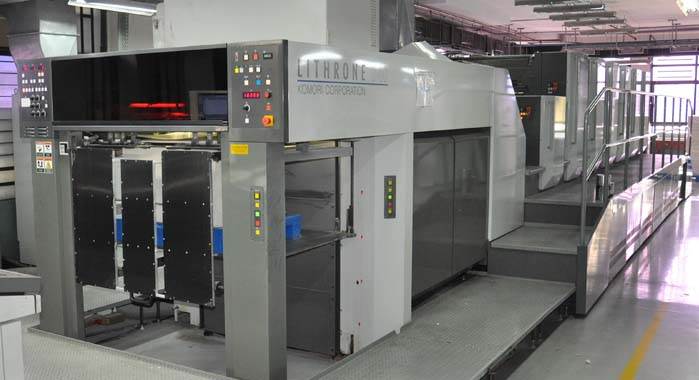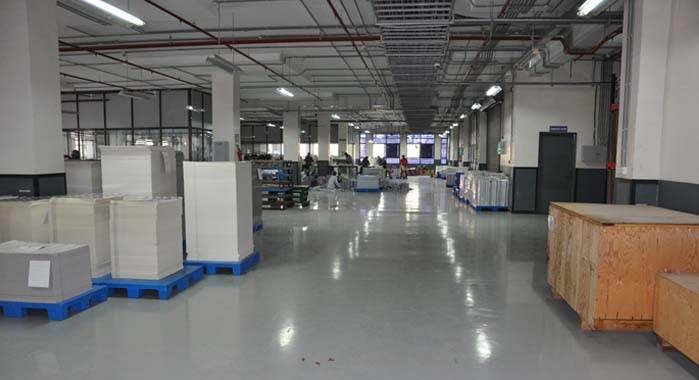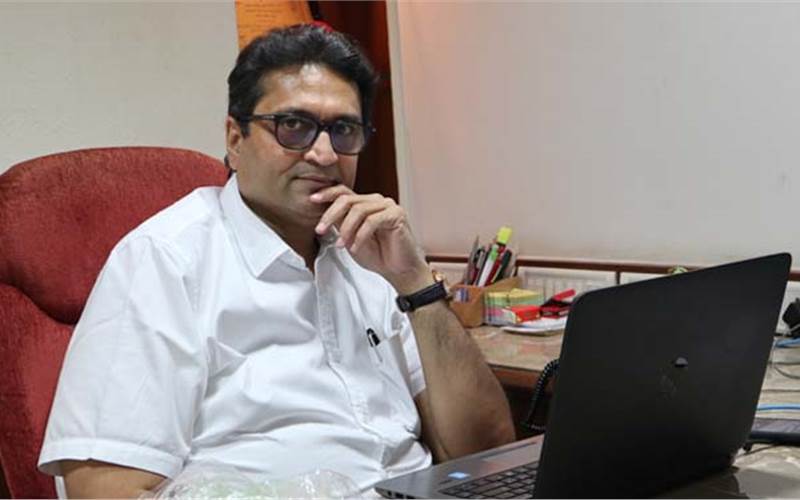Award Offset in future mode - The Noel D'Cunha Sunday Column
Nitin Shah, director of Mumbai-based Award Offset Printers & Packaging manages the privately held print company along with his brother Rajesh and nephew Krunal. His Rs 50-crore investment in infrastructure and print equipment is a pitch to transform his Navi Mumbai and Silvassa factories.
“At this time I may be investing more than required but my recurring expenses are going to be down in the later period. Productivity will increase. In the long run it is going to help us,” says Shah.<
12 May 2018 | By Noel D'Cunha
PrintWeek India (PWI): Many printers are migrating to packaging. But most of these firms are new to packaging. Some have made minor investments towards packaging or are aspiring about investing into packaging. What are the three things they must do or not do?
Nitin Shah (NS): Commercial printers have four-colour printing capabilities and are used to printing CMYK. But packaging printing is not always about process colours. There are spot colours involved, and require machines with multiple colour options. Commercial printers start using four colours for packaging jobs without considering this factor. This is not the right way to do things.
PWI: Explain!
Be it pharma, FMCG, cosmetic, or wine and spirit, among others, all are demanding the best in packaging, and just-in-time. Hence, there’s a need for not only quality printing, but automation that permits quick turnarounds. Good packaging printers which are in the industry for over 25 years are adopting the latest in technology. That’s the first: bring in automation. The second is costing. Commercial printers apply the same costing method for packaging that they deploy for commercial jobs. In packaging, the cost of the raw material cost is 65% whereas in commercial it is 30-35%. Such printers who do packaging jobs suffer the most when there are rejections. Three to four rejections can wipe off your entire year’s profits.
PWI: I see. Therefore, proper research and a proper methodology is an absolute must?
Yes. A commercial printer can stack up to 3,000 to 4,000 sheets on the press whereas when you are working with boards, you can stack up to 1,000 to 1,500 sheets, depending on the GSM of the board. The output gets reduced by three to four times. Before moving to a new segment, do proper research and find out whether you are ready to move into packaging.
PWI: How different is the converting operations in packaging?
If you are manufacturing cartons, there are many things to be kept in mind. Whether the carton has a varnish or UV, the accuracy of the UV layer which can affect the die-cutting process, and even the folding has to be accurate.
PWI: You also spoke about rejection, and the losses. In other words, packaging is not everyone’s cup of tea. When should such commercial printers, who have indulged in packaging return to doing what they are best at?
I have seen many good commercial printers who have not forayed into packaging. And yet, they are flourishing and making lots of innovations. One example is, Akar Printers. The company is into commercial, and their core is innovation. Then there’s Spectrum Scan, which specialises in retail display and are innovating every day plus they are growing. If the printer gets rejections continuously for two to three years, he must stop and return to commercial printing.

PWI: We discussed "people strength" at your impressive new factory in Silvassa. Please share your inputs about good employee retention technique or a way to tell a non-performer to go.
In today’s time, nobody is satisfied. The employee is looking for more remuneration and facilities while the employer seeks extra efficiency. There has to be a balance. Based on the experience, you have to negotiate salary. However, we at Award do not subscribe to the policy of sacking someone who does not meet our company’s standards without giving the person a chance or two.
PWI: What kind of HR policy does Award possess to motivate its 500 member taskforce?
Everybody is looking to get more. Now the time has come, how the employee has the expectation from the employer about the payments, facilities. In the same way, an employer has some expectations from the employees. I feel ten years is a long-term association with the company in this day and age. On that basis you can categorise individuals, and then based on that you can negotiate the remuneration. But if a person is not performing, then you have to tell him, directly. I feel removing a person is not good without giving him a chance or two.
PWI: Does it work?
A person who is ready to accept his shortfalls, and is willing to learn can be an asset to the company. But some rigid people want everything but will be performing as per their whim. You won’t find such workforce at Award. If you understand that person is right, then you can pay him what the market is paying plus the incentives.
PWI: Nitin-bhai, please share a bit on the handling of finance when it comes to the packaging business. Your mantra is "slow and steady".
There’s no doubt that you need to calculate everything – output requirement, downtime, recurring expenses. At this time I may be investing more than required, but my recurring costs are going to be down in the later period. Productivity will increase. In the long run, it is going to help us.
PWI: Please share how much a firm should juggle between technology, upgradation and return on investments.
In 2004, we invested in our first brand new machine. At that time we realised the difference between an old one and a new one. You can buy old machines at a cheaper rate and perhaps get a similar quality output too, but maintenance costs are high. A secondhand machine offers less depreciation than a new one. Capex on a new machine is on the higher side, but the returns are higher.
PWI: Is that why you have never shied away from being a first mover in key segments?
Yes. The thing is our fixed expenses are not going to change, regardless of how many shifts one runs or the number of tonnes one converts. It’s the variable expenses, which depends on the conversion. These are the advantages of new machines. The conversion becomes much faster. For a new machine, the total preventive maintenance or breakdown maintenance would not be more than 3-4% of the total Capex. For used machines, it amounts to 15-20% of the Capex. Along with the recurring cost if you calculate downtime, material wastages, and manpower, it is more sensible to invest more in a new machine.
Focus corrugation

The line is programmed to produce either E or F type flute at a time but optimise the accessories into a single line to save capital and operational cost.
This is used for production of inner cartons for packaging using the multi-colour offset printed top-sheet, this top layer is laminated onto the 2-ply produced using the laminator capable to handle the offset printed sheets at speeds of up to 120pcs/min.
PWI: In the good old days, investment was need-based?
That has changed. Now, we create facilities and then market our products. This is the significant change we have seen in the last 10-15 years.
PWI: How much automation is required on the press?
It depends on the criticality of the work your doing. For a normal CMYK or spot colour jobs, automation on the press may not be a must. But, if there are different jobs then CIP connection between the pre-press and press helps a lot in every changeover. Opting for features like auto blanket wash, auto plate wash, auto plate loading depends on job changeovers is a must. Certainly, there are advantages of automation, but you also need trained workforce to operate the press.
PWI: Certain automation is driven by the end-user...
True. Here it’s about becoming a preferred supplier. Automations like electronic inspection, auto packing, in-house pre-press helps in getting more business.
PWI: How do we compare with the international players?
Some years ago, I visited Color Druck, a packaging company in Germany. It’s a complete robot-enabled set-up, with only seven to eight people. From unloading the materials to storing it in the warehouse; from printing to die-cutting; and then folding glueing plus packaging of cartons and again packing it, robots carried out every single operation. One robot was costing Rs 70-80 lakhs. They had 20 robots.
PWI: Are robots a viable investment in India?
No, but in Germany, where there’s a shortage of manpower, it made sense.

PWI: Today there are a lot of options for a printing company in terms of choices. On the one side there are the traditional German, Swiss and Japanese heavyweights and on the other hand the influence of China plus new territories countries like Taiwan and Brazil. Also, there is a significant presence of Indian suppliers of machines and consumables. A bit from your experience and perspective about the multiple packages that you have come across and invested (machines and consumables).
If you saw some ten years ago, China used to produce two variant of the same equipment – one for the developed countries and the other for developing countries, in which, India was included. Today the scenario has changed. They give equal importance to India. They see India as a market they can’t neglect or ignore. Plus, from what I read, China’s domestic requirement for packaging converting equipment has saturated. With manufacturers from the developed countries having their pricing policies, India becomes a potential market for China.
Let’s keep politics aside, and think of business. I have seen the demonstrations of the Chinese machines. As of today, we are getting the desired output as committed by the Chinese companies. The world knows of the longevity of the German and the Japanese presses. As for its durability of the Chinese kit, it is difficult for me to comment right now. But given the cost difference, the Chinese machine look lucrative, plus the Indian dealers transact in Indian rupees and provide good after-sales support too.
PWI: Your perspective about the Indian packaging industry, and the potential for growth. The market data suggests: processed food packaging represents 48% of the total pie, personal care packaging is 27%, pharma is 6%, and the rest is 19%. How must a packaging firm invest? Create a market and invest; or invest and then create a market? Should one create or follow?
We have invested Rs 50-crore in machinery not to cater to today’s demand. Our plan is for five years down the line, when we expect the packaging requirement to grow manifold. As your numbers suggest, food, retail, cosmetic, FMCG segments as well as our present pharma segment, are growing. We expect rapid growth in the next few years. It makes more sense to be prepared and take advantage of the growing market, rather than wait for the market to grow and then invest.
PWI: What have been certain changes in terms of growth for our industry - when you set up Award at Navi Mumbai; and Award at Silvassa?
We got into the print business in 1972 with a letterpress. The offset was new to everyone then. In 1976, we got our first offset press at our Mahim factory. But I must say, the depth of letterpress print is unmatchable. You compromise on brightness when using offset.
PWI: Yet you shifted to offset...
What we achieved moving from letterpress to offset were faster turnarounds and faster conversions. In letterpress the output is slow, there’s wastage, and since drying prints is one of the processes, you need more space.
PWI: Why pharma?
We catered to the pharma sector then, we still do. It’s an industry that will never die. The population is on the rise, and there’s growing health awareness. But catering to the pharma industry is quite a challenge. You need specific systems and safety parameters in place. If you can master the art of catering to the pharma industries then you can cater other sectors. If one wants to become a significant player, catering only to the pharma sector will not be enough. There are other verticals like the FMCG, where there are volumes, can be the second segment.
Technology:
PWI: How must a packaging firm look at paperboard? As you mentioned during Seekho aur Samjho at the GIPT the importance of grain direction, bendability, stiffness etc...
Grain direction plays an important role in any packaging be it for shelf life, opening at the auto-cartonator, durability or compressibility – along the press cylinder or across that depends on the GSM of the paper. Paper and paperboard are two different types of substrates. When you are printing on paper, you have to print across the grain, across the cylinder and when you are printing on boards, you have to print along the cylinder.
PWI: So, how must an SME firm handle shorter runs especially, smaller sizes and special sizes?
It depends on the usual requirements. If your quantities are small but you know that they are guaranteed jobs every month, one can standardise the paper sizes to suit the need. Paper mills supply fixed sizes, but many a time we ask the mill to deliver sizes that match our requirements.
PWI: Very few factories look at cutting quality. Your comment on this?
It is the requirement of time. The direct-to-use boards give better output. You save on labour because you don’t trim the boards. Plus, trimming in-house could result in boards having flakes, buffs, and cross-cutting.
PWI: You follow the principle of direct printing with pre-cut board sizes; plus use superior tools and die cuts.
Automation and following a process is the need of the hour. Any organisation has to be system driven. Palletised boards are available, and they are not high-cost. Ready to use boards are beneficial, particularly for high-volume jobs.
PWI: Your factory is dust-free. How does one reduce dust in the factory; especially in the die-cutting stage?
Double-door entry, jointless flooring and epoxy coatings are the answer. Regular types of floorings attract dust, and it remains on the floor. Epoxy coating prevents the dust from settling. But yes, there is a high maintenance cost attached to jointless flooring and epoxy coating.
PWI: What about shopfloor maintenance?
Full-time house-keeping is a must. We have five persons engaged for house-keeping at our Navi Mumbai plant and seven at Silvassa.

PWI: One of the things you have aimed to do at your Silvassa factory is the elimination of mistakes. How can a small-sized firm achieve zero error?
We have quality checks at every stage, beginning from input raw material, which is tested at our labs, to post-print on-the-machine inspection systems. Testing of input raw material at the entry stage is crucial, and it doesn’t require a considerable investment. It can avoid a huge amount of wastage and possible downtime.
PWI: 2-5% waste; and the steps to achieve it?
Inspection at every stage, starting from the raw materials. Try to minimise manual inspection. An operator who begins in the morning can develop fatigue after a few hours of work. As a result, he may let a faulty carton pass. Therefore, conduct regular counselling for employees, and shopfloor workshop for the operators to educate and guide them on best practices. The day when everyone takes the ownership of the work, everything will be sorted.
PWI: What about investments?
As mentioned earlier, invest in new types of machinery. It reduces breakdowns, gives you consistent output. Carry out regular maintenance on your machines.
PWI: How did you create your QC authorised lab? Did you create or you followed?
Award was one of the first print converters to start a QC lab. We set one up in 2000 at our Navi Mumbai plant.
PWI: How so?
It all started in 1997-98 when India implemented the open-economy policy aimed at developing rural and remote areas. Baddi became the hub for industrial activities, and pharma companies began setting up their operations there. We were also asked to move. We had to make a decision – to move or stay put. We took a decision of not moving. Because it was just the beginning, our customer stuck to us, but for how long they would, they weren’t sure. Globalisation took place, and the world’s pharma companies started looking towards India, setting up operations here. They were also looking for print packaging partners for supplies to the regulated market. We had the capacity, but the regulated markets had its norms. One of them was to have a laboratory for inspection of input material, inline on the machine, and finished goods. Line clearance, cleanliness, changeover, inspection and checking were some of the requirements of the regulated markets. That’s when we started our QC lab, and catering to the regulated markets.
Process:
PWI: Among any number of global and local equivalents are guidelines issued by the US Food and Drug Administration (FDA); the British Retail Consortium (BRC) in the UK; and with a particular reference to print, the European Printing Ink Association (EuPIA) and tried and tested ISO. What are the certifications a firm should opt for?
One should have ISO 2001:2008 to 20015 as a minimum requirement. It shows that you are following the system, and everything is documented. If you want to enter into food packaging then BRC is a must. If you're going to cater to direct exports to the pharma companies of regulated markets and specific US markets, then you should have certification of Pharma Supply (PS). Today the requirement for OSHO has increased. There are standards for colours too.
You may have all these certifications yet fail the audit conducted by your customer. It means you have not implemented the rules of the certifications. It’s a teamwork. You need to have open-minded people, educated workforce and willingness to accept and change the system. I would go a step forward and say, here management should lead by example, others will simply follow.
PWI: Which ink must one use? Some say, thermal-based (solvent or water) or energy-curable (UV) based - the regulation-approved ink chemistries; while some say low-migration inks is governed by the drying or curing process they undergo. For example, solvent-based inks with excellent print quality are the norm for flexible packaging.
It all depends on the substrate and requirement of the customer. If I am doing food business, then I’ll be using food-safe inks. For pharma and food, it has to be low-migration inks.
PWI: Which software are de facto, now?
The software is the need of the hour. It helps analyse your print and processes, store them for recall, at a click of a button. We have an Esko workflow.
PWI: What do the brands insist on during their audits?
Some brands do, but not all insist on any particular workflow. All they need is that their jobs are printed as per their requirements and compliances.
PWI: Specific product requirements and compliance are just two elements that are crucial for a brand. A pharmaceutical customer will want to see a factory full of similar pharma-type work. The question for you is, should one keep production lines separate because the use of a substance that is suitable on, say, a bottle label might not be appropriate in a food label factory because of issues such as migration? Or it can be a mix and match?
Ideally one should have separate production lines to avoid mix-ups. Take, for example, pharma and food packaging. There are barriers in pharma – a primary package which protects the products. In food, the product comes directly in contact with the printed material. Converters who do both use same types of boards, food-grade boards like FSC, and the like. Hence a separate line for each is highly recommended.

PWI: Some of the packaging majors have in-house centres which enable customers to work with packaging experts to design and build new or improved packaging prototypes. Should design be in-house or outsourced?
It depends on what kind of service you are providing to your customers. If you have an in-house design team, then you will be in a position to suggest a structure of the package. An in-house design facility may be an expense, but it can make you a preferred business partner.
PWI: Award’s vision 2025?
Our aim for 2025 is to achieve conversion of 3,000 tonnes. We have invested Rs 50-crore in our recent expansion plan, but to reach our vision of 2025, will need lots of efforts and further investment. If everything goes well, we may look at starting a new plant down South.
PWI: What about the next-gen at Award?
My nephew, Krunal who is entrenched in the business now, is an IT-educated. One who has in-depth knowledge of IT can do a lot of things. Current technology involves IT infrastructure everywhere. Everything is software driven. He has done a printing technology course from London. My sons, Harsh, who is specialising in graphic design and Dhairya, who is studying marketing management, will soon be inducted into the Award management.
PWI: A good team. You relieved?
It is the generation-next, who will take our business forward and achieve the vision of 2025. During our father’s time, it was letterpress which we converted into offset and the next technology is digital. Let’s see how it pans out.
The future lies in upgrading

Award Offset has invested Rs 50-crore in the last few months. It includes a KBA Rapida 105 – seven-colour UV press with 4+3 intradeck, two Pratham leaflet folding machines, a GUK folder for leaflet folding, a Tiancen hot-knife 106x106 fully automatic laminating machine from Ample Graphics, a Bag-in-Box liner machine from Bobst H&B and an Autoprint Checkmate inspection system.
The Rs 50-crore investment also includes two Bobst kit – India’s first Speedwave device; a Bobst Novacut 106 with stripping and a Heiber and Schröder WP Speedliner; a Komori Lithrone GL 40 seven-colour coater; and a blanking machine from Ample Graphics. All the machines are expected to be installed towards the end of May or early June 2018.
Shah said, “The future is not bright for print companies that cannot upgrade,” quoting statistics. “According to the market reports, by 2020-2022, India will become the third largest packaging converter with over USD 32-billion at an annual growth rate of 13%.”
With the new investments involving automation, Shah, hopes to cater to the food, retail, cosmetic, FMCG segments as well as his present pharma segment, which he said, has seen a growing trend. “Our Navi Mumbai plant will be dedicated solely to pharma packaging, while the Silvassa plant has been constructed such that we will be able to cater to other verticals of packaging.”
At present Award converts 650 tonnes of paperboard per month. “With this investment, we should easily be able to convert three times of what we are doing and gear up for the future,” he said, adding, “This is a calculated investment, which we hope will start bearing fruits by 2019. We expect to face a return on investment of seven years.”














 See All
See All